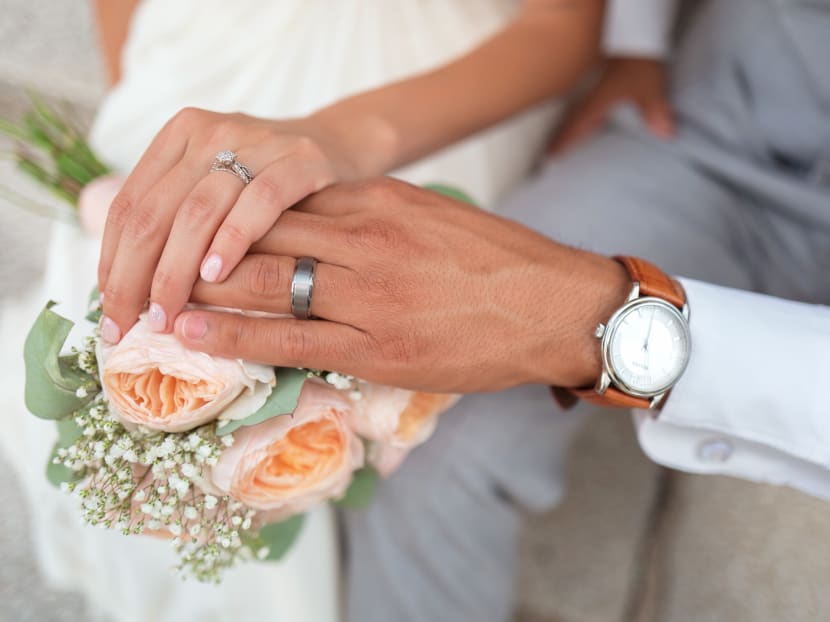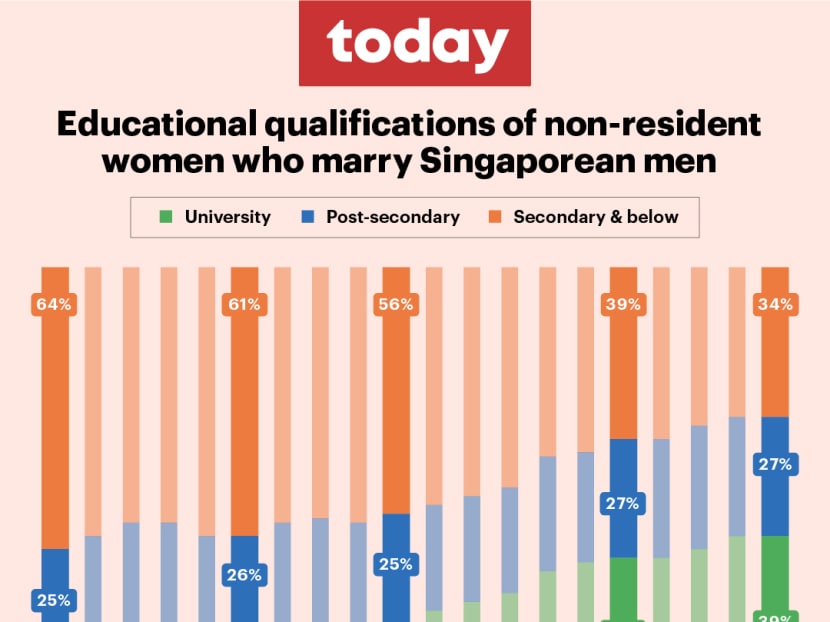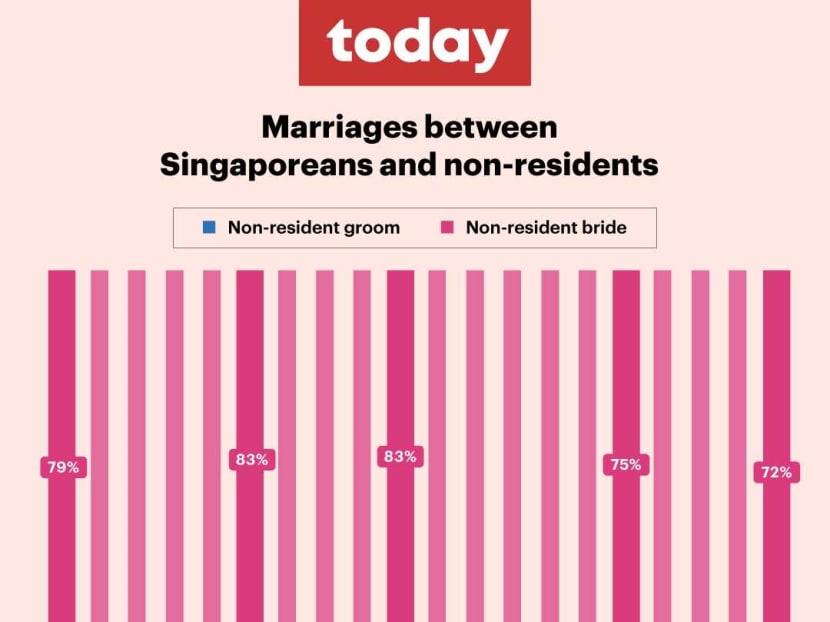Foreign brides marrying Singaporean men are older, better educated: MSF
SINGAPORE — Foreign brides who marry Singaporean men are becoming older and better educated than in the past, based on data released on Thursday (April 22) by the Ministry of Social and Family Development (MSF).

The number of Singaporean women who took non-resident grooms in the last two decades had jumped by 75 per cent, from 989 in 2000 to 1,727 in 2019, government data showed.
- More Singaporeans are marrying foreigners — 6,153 in 2019 versus 4,823 in 2000
- The increase is more apparent for Singaporean women in the last two decades
- As for foreign brides, the demographic has changed in the last two decades
- Their median age increased from 27 years old in 2009 to 29 in 2019
SINGAPORE — Foreign brides who marry Singaporean men are becoming older and better educated than in the past, based on data released on Thursday (April 22) by the Ministry of Social and Family Development (MSF).
With about one in four citizen marriages here involving a foreigner — a fairly constant proportion over the past two decades — it is the first time MSF has released data on the age and educational profile of foreign brides.
Analysts said that the demographic of non-resident brides — more than 90 per cent of whom hail from Asia — had changed in the last two decades as the region’s economic growth increased educational and employment opportunities.
Non-residents refer to those who are not Singapore citizens or permanent residents.
For one thing, the median age of these brides rose to 29 years old in 2019, up from 27 a decade earlier, the data showed. MSF’s latest data is from 2019.

In 2019, a majority of non-resident brides:
Were between the ages of 25 and 34 at the point of marriage (60 per cent)
Had post-secondary or university educational qualifications (78 per cent)
By contrast, back in 2000:
Slightly more than half, or 53 per cent, of non-resident brides were aged between 25 and 34 at the point of marriage
Fewer than four in 10, or 36 per cent, held post-secondary or university educational qualifications
The proportion of marriages involving non-resident brides below 25 years old had also fallen dramatically, from 36 per cent in 2000 to 12 per cent in 2019.
While MSF did not provide a breakdown of the brides’ countries of origin, the data showed that in 2019, they came from:
Asia (96.4 per cent)
Europe (1.4 per cent)
Oceania, which consists of Australia, New Zealand and Papua New Guinea (0.6 per cent)
North America, which consists of the United States and Canada (0.5 per cent)
Others (1.1 per cent)
In 2000, the proportions were:
Asia (98.5 per cent)
Europe (0.6 per cent)
Oceania (0.4 per cent)
North America (0.4 per cent)
Others (0.1 per cent)
SINGAPOREAN WOMEN MARRYING FOREIGNERS
While more Singaporeans were marrying foreigners — 6,153 in 2019 versus 4,823 in 2000 — the increase was more pronounced among Singaporean women in the last two decades.
The number of Singaporean women who took non-resident grooms in the last two decades had jumped by 75 per cent — from 989 in 2000 to 1,727 in 2019.
This is in contrast to the 15 per cent increase in the number of Singaporean men who took non-resident brides in 2019 compared to 2000 — 4,426, up from 3,834.

The demographic of non-resident grooms was fairly similar to two decades ago. The median age in 2019 was 31.3 years old, up only slightly from 30.6 years old in 2000.
There was also a slight increase in the percentage of non-resident grooms who held post-secondary or university qualifications — up from 73 per cent in 2000 to 78 per cent in 2019.
The foreign grooms in 2019 came from:
Asia (60 per cent)
Europe (20 per cent)
Oceania (6 per cent)
North America (6 per cent)
Others (7 per cent)
Sociologists contacted by TODAY said that with more Singaporean women going overseas to study, work and travel — and more foreign men coming to Singapore to do the same — the chances of them meeting and interacting vastly increase.
Professor Paulin Straughan from the Singapore Management University (SMU) said: “As women continue to prefer to marry grooms who match their education level, the pool of eligible men (in Singapore) is small.
“Thus, expanding the pool to those beyond Singapore will improve the likelihood that they may find a significant other and life partner.”
Ms Margaret Thomas, president of the Association of Women for Action and Research (Aware), highlighted a study that pointed out the distinct socio-economic advantages enjoyed by families with a migrant father over families with a migrant mother.
“Transnational families with a migrant father have the highest monthly per-capita family income (S$3,062) among all types of families. They also have a larger proportion of working mothers (80 per cent) than the other types of families,” she noted.
INCREASED PURSUIT OF HIGHER EDUCATION
MSF said that it annually publishes a series of aggregated statistical tables, such as on marriage and divorce on its website, to encourage research and raise public awareness on emerging family trends and issues.
The latest data was released as the profile of non-resident spouses is changing.
Prof Straughan of SMU said that Singapore has seen a normalisation of transnational marriages and the profile is similar to marriages among citizens.
“I think what is significant is the reduction in the proportion of marriages of less-educated Singaporean grooms to younger foreign brides from the region — the profile we noticed in the 1990s and 2000.
“I suspect the proportion of less-educated single Singaporean males is now lower as the educational achievement for Singaporeans has risen, which may explain the reduction.’’
The latest MSF data does not specifically examine the age and educational profile of Singaporean men taking foreign brides.
A decade ago, a surge in the number of older and less educated Singaporean men who took foreign brides was a matter of concern to social workers, because these families face challenges such as poverty, abuse and immigration issues.
Dr Tan Ern Ser, a sociology lecturer at the National University of Singapore, said that the increasing educational and employment opportunities resulting from economic growth in the region also contributed to the decline in young foreign women marrying Singaporean men.
Ms Thomas from Aware said that both secondary education and university enrolment rates across Southeast Asia have been steadily increasing over the past decade due to the growing demand for higher education in these countries.
“The rising age of migrant wives is likely associated with this increased pursuit of higher education. It’s possible that women are putting off marriage until a later age so as to attain their academic qualifications first, thus further improving their job opportunities.”











